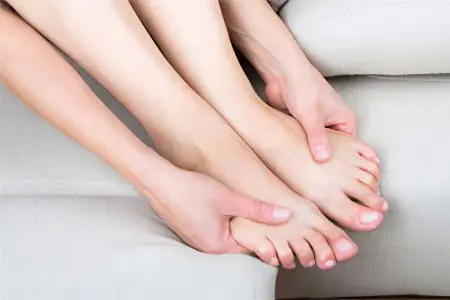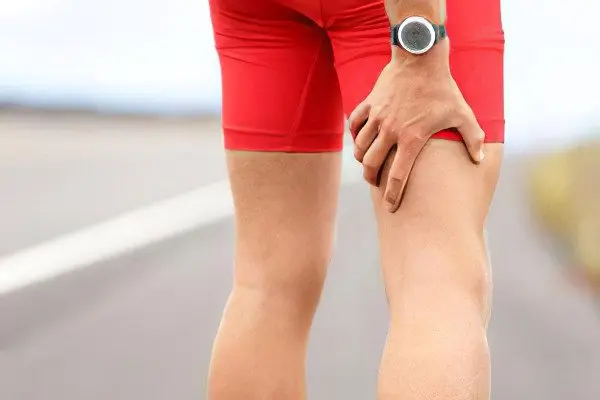
The feeling of numbness in the legs is familiar to almost every adult and even a child. Often this situation occurs after spending time in an uncomfortable position, when a person simply “has served” or “rested” his leg. When a limb is compressed, the blood supply is disrupted in it, and the nerves will not be able to transmit impulses normally. This situation is not dangerous and after a few minutes everything returns to normal.
However, sometimes numbness in the legs bothers a person for a long time. This may indicate a serious disorder in the body. Tolerate a deterioration in sensitivity should not be, you need to consult a doctor and find out the causes of this symptom.
Causes of leg numbness

The causes of numbness of the lower extremities can be hidden in the following diseases:
Peripheral neuropathy. In this case, the nerve fibers of the legs are not able to normally receive and transmit signals to the brain.
A variety of factors can provoke neuropathy, the most common of which are:
Diabetes. Neuropathy, with the corresponding symptoms, at a certain stage in the development of the disease manifests itself in every person. Legs become numb and sore in 70% of patients. The reason for the violations is hidden in metabolic failures that occur against the background of high blood sugar levels. In this case, small nerve fibers die. The pathological process begins with the legs.
Renal failure. Numbness will be caused by the accumulation of a large amount of toxins in the body.
Hypothyroidism. This disease contributes to a violation of the sensitivity of the legs due to malfunctions of the thyroid gland.
Avitaminosis. Vitamins are directly involved in the formation of the sheath of nerve fibers and in the conduction of impulses. If the body lacks vitamins of group B, vitamin A or E, then the first symptom of beriberi may be numbness of the legs.
Poisoning by toxic substances, such as glue, lead, mercury, etc.
Infectious diseases that affect nerve fibers. It can be the herpes virus, Epstein-Barr virus, HIV.
Diseases of an autoimmune nature. These include SLE, rheumatoid arthritis, and vasculitis.
Taking medications. These are means to eliminate convulsions, antibiotics, anti-tuberculosis drugs, cytostatics.
Deficiency in the body of magnesium, iron and calcium. These trace elements are directly involved in the process of transmission of a nerve impulse.
In addition to numbness in the legs, a person may be disturbed by symptoms such as paresthesia, tingling of the skin, unsteadiness of gait, a feeling that dense tissue has been pulled over the foot, lower leg or thigh. Possible pathological changes in the skin.
Mononeuropathy. In this case, only one nerve or nerve plexus is clamped.
This situation is observed in the following pathologies:
Sciatica. The disease is accompanied by inflammation or compression of the sciatic nerve. Numbness in the limb will disturb the person at night.
Tunnel syndrome develops when the tibial nerve, located in the region of the tarsal canal (it is located next to the ankle), is restrained. The feeling of numbness will spread to the foot and heel.
Any injury to the lower extremities can lead to pain and numbness. Moreover, if during a dislocation, fracture, sprain or bruise, the pain is acute, then it becomes aching. Often such symptoms haunt a person throughout life, since a damaged nerve or tendon may not fully recover.
Neurom Morton. This disease is accompanied by compaction of the nerve passing between the long bones of the foot. Therefore, the feeling of numbness will be localized in this area.
The lateral part of the lower leg and foot becomes numb with neuritis of the peroneal nerve.
Sometimes numbness in the legs worries a person who has been walking in tight and uncomfortable shoes for the whole day. Unpleasant sensations debut after he takes off his shoes. Discomfort intensifies at night.
Diseases associated with damage to the spinal cord. If the transmission of nerve impulses is impaired at the level of the spinal cord, then in addition to a feeling of numbness in the legs, a person will experience muscle weakness. Other organs located in the small pelvis will cease to perform their functions in full.
The most common causes of such violations are:
The growth of a hernia in the space between the vertebrae.
Osteochondrosis of the lumbar spine.
Tumor of the spinal cord.
congenital stenosis.
Multiple sclerosis. This is an autoimmune pathology that damages the myelin sheaths of the nerve trunks.
Thus, congenital and acquired disorders in the functioning of the spinal cord can cause numbness in the leg.
[Video] Dr. Sampiev – A common cause of leg numbness is spinal stenosis:
A spinal hernia requires surgical intervention. Patients with heart failure should be hospitalized, as well as patients with strokes and thromboses.
For the treatment of neuropathy, vitamin-mineral complexes, vascular preparations are used. Rheumatic diseases require the use of glucocorticosteroids. According to the indications, the patient is prescribed physiotherapeutic procedures: UHF, paraffin therapy, magnetotherapy, taking baths with radon or hydrogen sulfide, etc.
Numbness prevention measures that can be implemented at home:
Maintaining a healthy lifestyle, giving up bad habits.
Wearing comfortable shoes, correctly selected from an orthopedic point of view.
Timely treatment of injuries.
Taking foot baths.
Performing a foot massage.
Taking a contrast shower.
Moderate physical activity. To improve blood circulation in the lower extremities, a person should walk for at least half an hour a day.
If the doctor prescribes any medicines, then it is necessary to take them on schedule.
[Video] Dr. Kirichenko – Exercises for numbness of the thigh, lower leg and foot:









